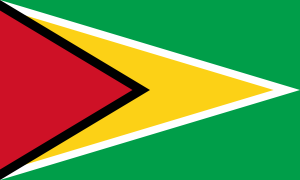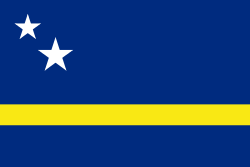Paramaribo
| Paramaribo | |
|---|---|
| Capital city | |
|
The street Waterkant in Paramaribo | |
| Nickname(s): Par'bo | |
 Paramaribo The location of Paramaribo in Suriname | |
| Coordinates: 5°52′N 55°10′W / 5.867°N 55.167°WCoordinates: 5°52′N 55°10′W / 5.867°N 55.167°W | |
| Country |
|
| District | Paramaribo District |
| Founded | 1603 |
| Area | |
| • Total | 182 km2 (70 sq mi) |
| Elevation | 3 m (10 ft) |
| Population (2012 census) | |
| • Total | 240,000 |
| • Density | 1,300/km2 (3,400/sq mi) |
| Time zone | ART (UTC-3) |
Paramaribo (Dutch pronunciation: [ˌpaːraːˈmaːriboː], nickname: Par′bo) is the capital and largest city of Suriname, located on banks of the Suriname River in the Paramaribo District. Paramaribo has a population of roughly 240,000 people (2012 census), almost half of Suriname's population. The historic inner city of Paramaribo has been a UNESCO World Heritage Site since 2002.
Name
The city is named for the Paramaribo tribe living at the mouth of the Suriname River; the name is from Tupi-Guarani para "large river" + maribo "inhabitants".[1]
History

The area, a trading post started by the Dutch, was taken by the English in 1630, and in 1650 the city became the capital of the new English colony. The area changed hands often between the English and Dutch but it was in Dutch hands again in 1667 and under Dutch rule from 1815 until the independence of Suriname in 1975.
Paramaribo is home to a historic Jewish community.[2] One of the oldest synagogues in the Americas is located in Paramaribo. It was built in 1685 near the Suriname River.[3]
In January 1821, a fire in the city centre destroyed more than 400 houses and other buildings. A second fire in September 1832 destroyed another 46 houses on the western part of the Waterkant.
In 1943 a military plane crashed on its way to North Africa near the city, killing two FBI Agents and 33 other people who were on board. The cause of the aircraft accident was never determined and very few remains of the 35 people aboard were found.[4]
Geography
The city is located on the Suriname River, approximately 15 kilometres (9.3 mi) inland from the Atlantic Ocean, in the Paramaribo district.
Climate
Paramaribo features a tropical rainforest climate, under the Köppen climate classification. The city has no true dry season, all 12 months of the year average more than 60 mm of precipitation, but the city does experience noticeably wetter and drier periods during the year. September through November is the driest period of the year in Paramaribo. Common to many cities with this climate, temperatures are relatively consistent throughout the course of the year, with average high temperatures of 31 degrees Celsius and average low temperatures of 22 degrees Celsius. Paramaribo on average sees roughly 2200 mm of rain each year.
| Climate data for Paramaribo | |||||||||||||
|---|---|---|---|---|---|---|---|---|---|---|---|---|---|
| Month | Jan | Feb | Mar | Apr | May | Jun | Jul | Aug | Sep | Oct | Nov | Dec | Year |
| Record high °C (°F) | 33 (91) |
34 (93) |
35 (95) |
37 (99) |
37 (99) |
36 (97) |
37 (99) |
37 (99) |
36 (97) |
37 (99) |
36 (97) |
36 (97) |
37 (99) |
| Average high °C (°F) | 30 (86) |
30 (86) |
30 (86) |
31 (88) |
30 (86) |
31 (88) |
31 (88) |
32 (90) |
33 (91) |
33 (91) |
32 (90) |
30 (86) |
31 (88) |
| Daily mean °C (°F) | 26 (79) |
26 (79) |
26 (79) |
27 (81) |
27 (81) |
27 (81) |
27 (81) |
27 (81) |
28 (82) |
28 (82) |
27 (81) |
26 (79) |
27 (81) |
| Average low °C (°F) | 22 (72) |
22 (72) |
22 (72) |
22 (72) |
23 (73) |
22 (72) |
22 (72) |
23 (73) |
23 (73) |
23 (73) |
23 (73) |
22 (72) |
22 (72) |
| Record low °C (°F) | 17 (63) |
17 (63) |
17 (63) |
18 (64) |
19 (66) |
20 (68) |
20 (68) |
15 (59) |
21 (70) |
20 (68) |
21 (70) |
18 (64) |
15 (59) |
| Average precipitation mm (inches) | 200 (7.87) |
140 (5.51) |
150 (5.91) |
210 (8.27) |
290 (11.42) |
290 (11.42) |
230 (9.06) |
170 (6.69) |
90 (3.54) |
90 (3.54) |
120 (4.72) |
180 (7.09) |
2,220 (87.4) |
| Source: Weatherbase[5] | |||||||||||||
Demographics
| Historic Inner City of Paramaribo | |
|---|---|
| Name as inscribed on the World Heritage List | |
 | |
| Type | Cultural |
| Criteria | ii, iv |
| Reference | 940 |
| UNESCO region | Latin America and the Caribbean |
| Inscription history | |
| Inscription | 2002 (26th Session) |
Paramaribo has a population of 240,924 people (2012 census). The city is famed for its diverse ethnic makeup, including Creoles (African descent) 27%, Hindustanis (East Indian descent) 23%, Multiracials 18%, Maroons (descendants of escaped African slaves) 16%, Javanese (Indonesian descent) 10%, Indigenous (descendants of native population) 2%, Chinese (descendants of 19th-century contract workers) 1.5%, and smaller numbers of Europeans (primarily of Dutch and Portuguese descent), Lebanese and Jews. In the past decades significant amounts of Brazilians, Guyanese and new Chinese immigrants have settled in Paramaribo.
Economy
Paramaribo is the business and financial centre of Suriname. Even though the capital city does not produce significant goods itself, almost all revenues from the country's main export products gold, oil, bauxite, rice, and tropical wood are channeled through its institutions. All banks, insurance corporations and other financial and commercial companies are headquartered in Paramaribo. Around 75 percent of Suriname's GDP is consumed in Paramaribo.
Tourism is an increasingly important sector, with most visitors coming from the Netherlands.[6]
Transport
Paramaribo is served by the Johan Adolf Pengel International Airport and Zorg en Hoop Airport for local flights. The Jules Wijdenbosch Bridge, which is part of the East-West Link, connects Paramaribo with Meerzorg on the other side of the Suriname River.
Most airlines like Gum Air, Caricom Airways and Blue Wing Airlines have their head offices on the grounds of Zorg en Hoop Airport in Paramaribo.
Education
Paramaribo's institution of higher learning is Anton de Kom University of Suriname, the country's only university.
Notable landmarks


- Suriname Mosque
- National Assembly of Suriname
- Neveh Shalom Synagogue
- Roman Catholic St Peter and St Paul Cathedral
- The Arya Dewaker Hindu Temple
- Presidential Palace of Suriname Presidential Palace
- Garden of Palms, a landscape garden of royal palms behind the presidential palace
Sports
Paramaribo is also the birthplace of several football players; some of them later represented the Netherlands:
- Maarten Atmodikoro
- Regi Blinker
- Edson Braafheid
- Romeo Castelen
- Edgar Davids
- Henk Fräser
- Ulrich van Gobbel
- Jimmy Floyd Hasselbaink
- Jerry de Jong
- Kelvin Leerdam
- Stanley Menzo
- Clarence Seedorf
- Andwélé Slory
- Mark de Vries
- Fabian Wilnis
- Aron Winter
Other sports such as badminton, tennis, swimming, track & field athletics, cycling, golf, volleyball and basketball are also commonly played in Suriname.
Paramaribo is also the birthplace of kickboxer and Mixed Martial Artist Tyrone Spong.
Twin towns – Sister cities
Paramaribo is twinned with:
-
.svg.png) Antwerp, Belgium.
Antwerp, Belgium. -
 Hangzhou, China.
Hangzhou, China. -
 Georgetown, Guyana
Georgetown, Guyana -
 Willemstad, Curaçao.[7]
Willemstad, Curaçao.[7] -
 Yogyakarta, Indonesia.
Yogyakarta, Indonesia.
See also
References
| Wikivoyage has a travel guide for Paramaribo. |
- ↑ E.M. Pospelov, Geograficheskie nazvaniya mira (Moscow: Russkie slovari, 1998), p. 322.
- ↑ "Extract of the Dutch Map Representing the Colony of Surinam". World Digital Library. 1777. Retrieved 2013-07-13.
- ↑ Fox, Tamar (18 February 2011). "Discovering Suriname's Jewish past - and present". Travel (Washington Post). Retrieved 13 July 2013.
- ↑ "Office Down Memorial Page".
- ↑ "Weatherbase: Historical Weather for Paramaribo".
- ↑ http://www.statistics-suriname.org/images/pdf/verkeers_vervoer_publicatie2011.pdf|
- ↑ Willemstad World Heritage City. Curacaomonuments.org. Retrieved on 2012-05-19.
| ||||||||||||||
|

